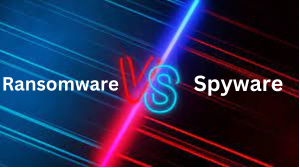Ransomware and spyware are two types of malicious software, or malware, that cybercriminals use to extort money or steal data from victims. Both can infect computers and mobile devices and lead to compromised privacy, stolen funds, and other headaches. But ransomware and spyware have some key differences in how they operate.
Contents
Understanding Ransomware
Ransomware is a form of malware that encrypts files on a victim’s device, rendering them inaccessible until a ransom is paid. The ransom demand usually asks for cryptocurrency payments, such as Bitcoin, to unlock the files. Most ransomware is spread through phishing emails containing infected attachments or links to malicious sites. Once clicked, the ransomware installs and executes its encryption payload.
Modern ransomware strains like Ryuk, Conti, and REvil use robust encryption algorithms to lock files. Decryption is difficult without the correct decryption key held only by the attackers. Victims often have no option but to pay the ransom or lose access to their data indefinitely. Ransomware impacts businesses of all sizes as well as government agencies, hospitals, and everyday internet users.
Key Characteristics of Ransomware
- Encryption: Ransomware employs advanced encryption algorithms to lock victims out of their files or systems. This encryption is usually so robust that decryption without the designated key is practically impossible.
- Ransom Notes: Once files are encrypted, victims are confronted with ransom notes, providing instructions on how to pay the ransom and regain access to their data. Non-compliance often results in permanent loss of data.
- Cryptocurrency Transactions: To maintain anonymity, ransomware operators demand payments in cryptocurrencies like Bitcoin or Monero, making it challenging for law enforcement agencies to trace the transactions.
- Evolution of Ransomware Strains: The threat landscape continually evolves as cybercriminals develop new strains of ransomware, each more sophisticated than the last. Notable examples include WannaCry, Ryuk, and Maze.
Understanding Spyware
Spyware, on the other hand, is a more covert form of malware that focuses on gathering sensitive information without the user’s knowledge. Its primary goal is to spy on the victim, monitoring activities, capturing keystrokes, and exfiltrating confidential data to external servers controlled by attackers.
Key Characteristics of Spyware
- Stealthy Operation: Spyware operates discreetly, often evading detection by traditional antivirus programs. It infiltrates systems through deceptive downloads, email attachments, or exploiting software vulnerabilities.
- Data Collection: Spyware is designed to collect a wide range of data, including login credentials, financial information, browsing habits, and personal communications. This stolen information can then be exploited for various malicious purposes.
- Remote Control: Some advanced spyware variants enable attackers to take remote control of an infected system, allowing them to manipulate files, install additional malware, or even use the compromised device as part of a larger botnet.
- Corporate Espionage: While individuals are certainly targets, spyware is also used for corporate espionage, with attackers seeking proprietary information, intellectual property, or trade secrets.
Key Differences Between Ransomware vs Spyware
While ransomware and spyware are both malicious programs used to target victims online for financial gain, they have some notable differences:
- Intent – ransomware intends to overtly take systems hostage while spyware silently steals data in the background.
- Encryption – ransomware uses encryption algorithms to lock access to files and networks whereas spyware typically does not encrypt anything.
- Impact – ransomware causes immediate business disruption upon execution; spyware theft can go undiscovered for months or longer.
- Payment – ransomware demands direct payment from the victim to unlock systems while spyware indirectly monetizes stolen data.
- Execution – ransomware launches quickly focusing on high-value targets while spyware operates slowly targeting high-value data over time.
Conclusion
In the dynamic landscape of cybersecurity, understanding the nuances of ransomware vs spyware is crucial for implementing effective defense strategies. Both threats exploit vulnerabilities in human behavior and system security, emphasizing the need for a multi-layered approach to cybersecurity.
As we navigate the digital era, staying informed about evolving threats and adopting proactive measures remains paramount in safeguarding against the ever-present dangers of ransomware and spyware.

